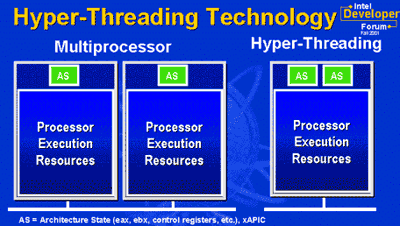Anand heeft een informatief verhaal online gezet over de Hyper-Treading technologie van Intel. Een probleem van alle huidige processors, en ook de Pentium 4, is de inefficiency. Volgens Intel gebruiken de meeste programma’s niet meer dan 35 procent van de execution units van de pentium 4.
Een mogelijke oplossing van dit probleem is Hyper-Treading. Een Hyper-Treading processor wordt door het OS gezien als twee logische processors waardoor twee “programma’s” tegelijkertijd uitgevoerd kunnen worden. Als het ene programma de ALU units zwaar gebruikt en het andere programma de FPU units kan dit een flinke performance boost geven. Als beide programma’s echter dezelfde execution units gebruiken heeft Hyper-Treading juist een negatieve invloed op de performance.
Dit is waarschijnlijk ook de reden dat Hyper-Treading nog niet gebruikt wordt bij de huidige Pentium 4 processors. Volgens AnandTech is het enige wat nodig is om deze feature aan te zetten een BIOS update, maar omdat veel desktop gebruikers geen geschikte programma’s gebruiken heeft Intel ervoor gekozen om Hyper-Treading voorlopig alleen te introduceren bij server en workstation CPU’s. Als laatste wordt de Hyper-Treading technologie vergeleken met AMD’s dual-core aanpak:
Given today's packaging technology and limitations, Hyper-Threading makes much more sense for the mass market than a dual-core approach such as what AMD is rumored to be considering for the higher-end Sledge Hammer CPUs. Until technologies such as Bumpless Build-Up Layer packaging can be perfected, the costs associated with producing a multi-core CPU may be too high for more than a very small portion of the market.
It's interesting to note how different AMD and Intel have become over the years. From the days of manufacturing essentially clones of Intel CPUs to taking a drastically different approach to the future of workstation and server CPUs, AMD has come a very long way indeed. If the higher-end Sledge Hammer CPUs do end up featuring two cores it will promise much higher performance than Hyper-Threading can offer because of the fact that there will be double the execution units thus avoiding some of the problems we have addressed today. Again, the biggest downside being the manufacturing of such a chip; we have explained in the past the perils of producing complicated CPUs.
 |
Met dank aan Verwijderd voor de tip.
